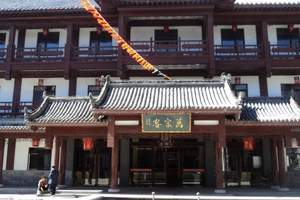抗美援朝战争纪念馆
4A地址: 暂无
开放时间: 暂无

更多热门城市
景点印象
就在丹东市内,交通很方便,不要门票,免费进场。去的时候,人很多,一部分旅行者,还有一群小学生来参观学习,参观时间1个小时左右
里面收藏了很多古物,有些抗美援朝时期的大炮,飞机,坦克什么的也在里面,一进去,能感觉到一种很浓厚的文化气息,武器很老式,中国在当时情况下对抗美国,不禁自豪
我是下午去的,它里面有很多当时的兵器和战争照片,气氛有点沉重,不由想起中国为朝鲜战争付出的巨大代价,激发起了我和我朋友心中的爱国心
看到了很多当时战争遗留下来的东西,例如飞机大炮之类的,有种还原当时的情景。意义很大,让中国人不忘当时抗美援朝战争留下的血汗,也让隔壁的朝鲜看到我们浓厚的兄弟情谊
战争纪念馆。虽然目测死的美国人名单比韩国人多,但是当时中国五十万的军队抗美援朝,牺牲的也是很多的。战争留下的永远都是悲伤!
抗美援朝战争纪念馆研究员张中勇指出,从20世纪末开始,抗美援朝纪念馆通过民政部下发通知,同时派员到除西藏外的全国480多个地级市的2670个县区单位,从地方最基本的县区民政烈士名单里面,逐一进行核对,于2006年公布了志愿军直接战斗牺牲的人数为183,108人。
Worth a visit to see how the conflict was viewed by PRC/DPRK. Displays are quaint and nowhere near caliber of Smithsonian Air and Space museum, but still worth a couple hour visit if you have the time.
If you have been to Pyongyang and seen the museum related to the Korean War from the North Korean viewpoint, then this museum is interesting to view as it gives a different perspective from the Chinese. There are a lot of different pictures and pieces to see in this museum and was overall an interesting experience. I went on a cold February day when it was just in the minus temperatures outside. The museum is not heated and it felt abut another 5 -10 degrees colder INSIDE. I strongly suggest you wear a coat and gloves
See only because there are so few places like. It compares to the museum in Pyongyang but not as intense, though they still keep up the lie that America started the war. Worth a couple if hours if your time. Don't for to play on the war toys in the field beside it.
I visited Dandong with my gf for our trip to North Korea. This museum was a last minute decision but I'm glad we didn't miss it.The collection is very big with English explanations on the displays. The whole museum (almost) is surprisingly politically correct, but you can still find some gems if you read all the captions. Don't miss photo-ops at the war scene panorama!
Admission for the museum is free, but if yo come by car you'll have to pay a parking fee. When we were there it was rather crowded and we had to queue to be given a ticket from one man to later give it back to another man after having stood in a second queue. Both moved very fast, so no worries. You are allowed to bring camera, but no rucksacks or lighters. A man controlling the queue asking for these things. Inside there is a path set up which you have to follow although you obviously don't have to read more than what interest you. Everything is in English, and as previous reviewer have written it can get rather tiresome to continuously hear such a one-sided story (and none of us were American, nor South Korean). Nonetheless it is very interesting to read about China's view on the whole situation and I can imagine that the western version was much more biased a few decades ago too.
Admission was free to this large museum with interesting displays. Free admission to museums is rare in China. Most of the main displays had English translations. This museum will irk American and South Korean visitors who have studied the history of the Korean War because of its extremely biased and IMO inaccurate account of the war. Nevertheless, it's interesting to see what the Chinese government teaches its citizens about it. You'll notice there is very little information about Chinese and North Korean casualties and battle losses...
丹東の町の、すこし丘高い所にあります。 毛沢東と金日成の握手から始まり、朝鮮戦争の中国・北朝鮮側のストーリーに沿って展示されています。 中国の人と訪問しましたが、なぜ中国人の犠牲を、そこまで払ったのかは理由は判らないとの事です。 特に何かある町ではないので、時間があればお奨めです。 それと、丹東はさくらんぼが美味しいとの事です。
朝鮮戦争に関する博物館です。当然ながら、義勇軍を送った中華人民共和国の立場からの展示になっております。同じ戦争でも立場が違えば、評価も全く異なるという一つの例です。現代史に関心がある方は訪問すべきですが、そうでなければ退屈するでしょう。
in cima ad una collina, consigliabile recarsi in taxi, c'è una grande costruzione contenente cimeli, fotografie e la storia della Guerra di Corea. Sul piazzale ci sono carri armati, cannoni, aerei, perfino un biplano, e un treno dell'epoca. All'interno in varie sale sono esposti moltissimi documenti e testimonianze della guerra con spiegazioni sia in cinese che in inglese. Tra i più interessanti il documento originale dell'armistizio firmato dal Gen. Clarke e dalle controparti coreane e cinesi, infatti furono ben 200.000 i volontari cinesi morti per aiutare il paese amico tra i quali anche un figlio di Mao-Tse-Tung. Nelle varie bacheche sono custodite pistole, mitragliatrici e le varie mappe della Corea. Il top di tutto il museo tuttavia è in cima ad una ampia rampa dove si accede ad una specie di planetario di 360° che rappresenta in modo vivo e realistico la guerra! E' tutto dipinto, in cielo tra le nubi si vedono gli aerei che bombardano o attaccano le postazioni nemiche, in basso tra carri armati, blindati, cannoni e postazioni d'artiglieria ci sono manichini in uniforme e con le armi in mano tra gli incendi e i morti, desidero specificare che la scenografia è spettacolare, se il museo è interessante questa scenografia è spettacolare!





